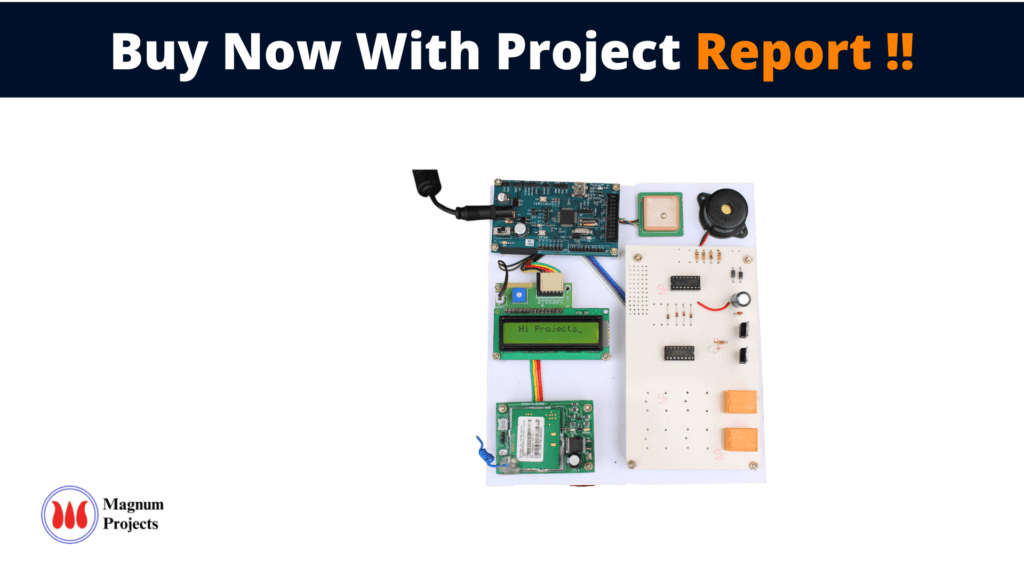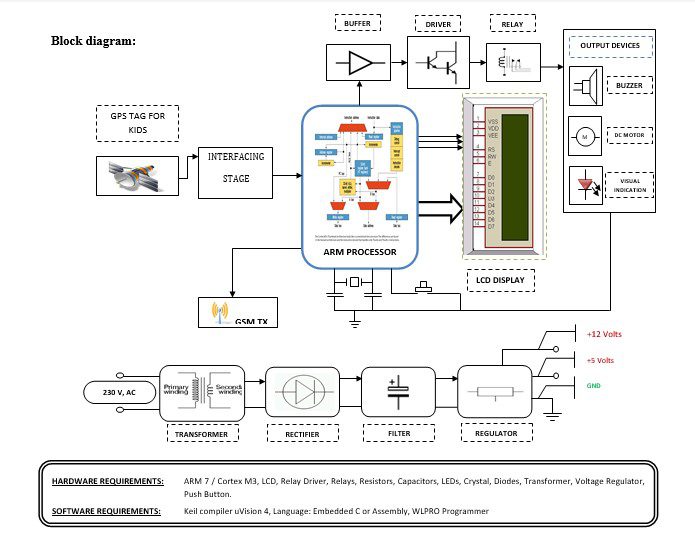Table of Contents
Introduction:


In this project, the tracking system will use GPS (Global Positioning System)and GSM(Global System for Mobile Communications)as the tracking system tools. GPS is a radio navigation system that allows us to determine the exact location (longitude and latitude)by calculating the time difference for signals from different satellites to reach the receiver.
GSM is a leading digital cellular system, which digitizes and compresses data, then sends it down a channel with two other streams of user data, each in its time slot.
The purpose of this project is to keep track of the kids when they are in the school area. This small, lightweight device is simple and can be carried or attached to a child’s clothing, belt, or smart cards. At the end of this project, a device that Is convenient for the school authority to guard the kids will be produced.


Block diagram explanation :
Power supply unit:
This section needs two voltages viz., +12 V & +5 V, as working voltages. Hence specially designed power supply is constructed to get regulated power supplies.
GPS module:
This is a GPS Receiver (5V Serial) with high gain having 4 Pin 2.54mm pitch strip. The third-generation POT (Patch Antenna on Top) is used by the receiver for the GPS module. It can be interfaced with normal 5V ARM7 with the help of the in-built 3V-5V converter. The interfacing is made easier with the help of a low pin count (4-pin) strip. The 4 Pins are 5V, TX, RX, and GND. This standalone 5V GPS Module does not require external components. It consists of an internal RTC Back up battery and can be directly connected to the USART of the ARM7.
The current date, time, longitude, latitude, altitude, speed, and travel direction / heading among other data, are provided by the module and can be used in many applications including navigation, fleet management, tracking systems, mapping, and robotics. The module can support up to 51 channels. The GPS solution enables small form factor devices which deliver major advancements in GPS performance, accuracy, integration, computing power, and flexibility. They are used to simplify the embedded system integration process.
GSM:
GSM Shield (SIM 900a): The SIM900 which is a complete Quad-band GSM/GPRS solution comes in a SMT module that can be embedded in customer applications. Featuring an industry-standard interface, the SIM900 delivers GSM/GPRS 850/900/1800/1900MHz performance for Data, voice, SMS, and Fax in a small form factor and with low power consumption. SIM900 can fit almost all the space requirements in the M2M application with dimensions of 24mm x 24mm x 3 mm. SIM900 is designed with a very powerful single-chip processor integrating AMR926EJ-S core. Quad-band GSM/GPRS module with a size of 24mmx24mmx3mm, SMT type suit for customer application, An embedded Powerful TCP/IP protocol stack Based upon the mature and field-proven platform, backed up by our support service, from definition to design and production.
NOTE: Modem may change.
ARM processor:
ARM is a computer processor-based RISC architecture. A RISC-based computer design approach means ARM processors require significantly fewer transistors than typical processors in average computers. This approach reduces costs, heat, and power use. The low power consumption of ARM processors has made them very popular:
The ARM architecture (32-bit) is the most widely used in mobile devices, and the most popular 32-bit one in embedded systems.
ARM processor features include:
- Load/store architecture.
- An orthogonal instruction set.
- Mostly single-cycle execution.
- A 16×32-bit register
- Enhanced power-saving design.
Buffers:
Buffers do not affect the logical state of a digital signal (i.e. a logic 1 input results in a logic 1 output whereas logic 0 input results in a logic 0 output). Buffers are normally used to provide extra current drive at the output but can also be used to regularize the logic present at an interface.
Drivers:
This section is used to drive the relay where the output is the complement of input which is applied to the drive but the current will be amplified.
Relays:
It is an electromagnetic device that is used to drive the load connected across the relay and the o/p of the relay can be connected to the controller or load for further processing.
Indicator:
This stage provides a visual indication of which relay is actuated and deactivated, by glowing respective LED or Buzzer.
Methodology:
This proposed work is an attempt to design a tracking unit that uses the global positioning system to determine the precise location of a school kid to which it is attached and using a GSM modem this information can be transmitted to remote users. This system contains a single-board embedded system that is equipped with GPS and GSM modems along with an ARM processor. During object motion, its location can be reported by SMS message. A software package is developed to read, process, analyze and store incoming SMS messages. The use of GSM and GPS technologies allows the system to track objects and provides the most up-to-date information about kids which is having a GPS tag.
Advantages:
- This system has many advantages such as large capability, and wide areas range.
- Low operation costs, effective, Strong expandability.
- Easy to use in vehicle traffic administration.
- Upgrading this setup is very easy which makes it open to future a requirement which also makes it more efficient.
Disadvantages:
- In actual use, this project will be operated on a rechargeable battery. So this battery needs to be recharged. For the longer operation of the battery, we need to use low-power consumption devices, ICs, and components; this will increase the cost of the system.
Applications:
- This system finds its application in real-time traffic surveillance. It could be used as a valuable tool for real-time traveler information, congestion monitoring, and system evaluation.
- An intelligent, automated vehicle tracking system can resolve the following problems such as late arrivals
- To schedule, improper use of company time and resources, unsafe driving habits, assigned routes, inefficient dispatching, and passenger dissatisfaction.
- This can lead to better traffic flow modeling and a better understanding of driver behavior.
- This project includes various features like ingenuity, simplicity of design, and easy implementation.
- It is completely integrated so that once it is implemented in all vehicles, then it is easy to track vehicles at any time.




